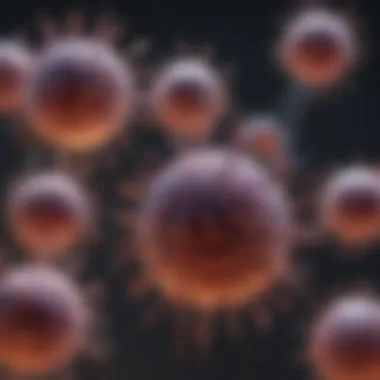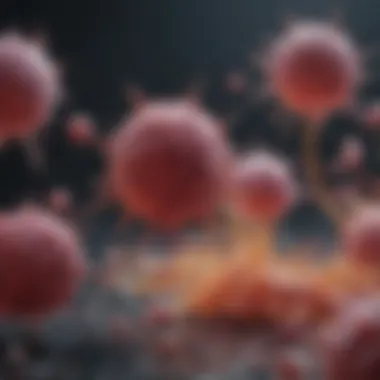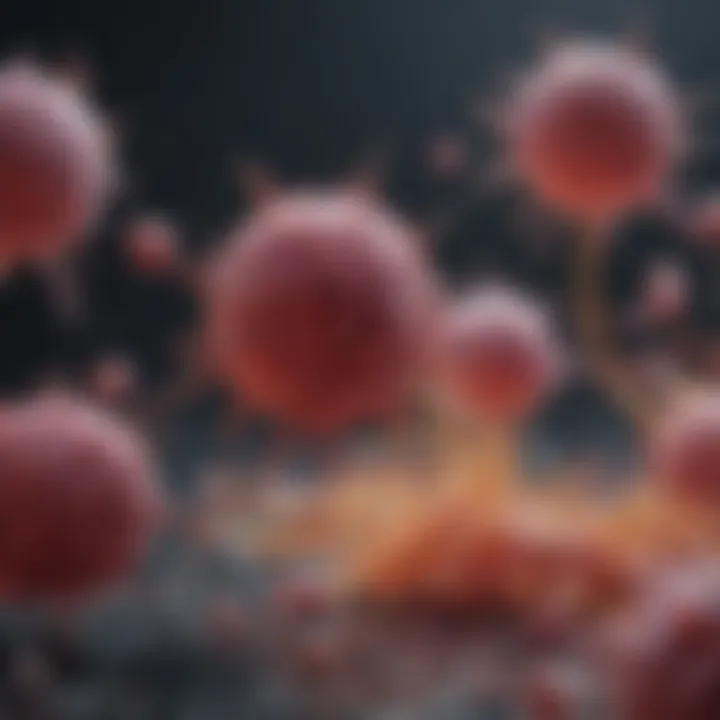Understanding Cytotoxic T Cells: Their Role in Immunity


Intro
Cytotoxic T cells play a pivotal role in the immune system's response to pathogens and cancerous cells. Understanding how these cells operate is crucial for appreciating their impact on health and disease. This section will introduce key concepts that underline their functions and therapeutic potential.
Key Findings
Cytotoxic T cells are characterized by their ability to directly kill infected or malignant cells. They achieve this through several mechanisms, including the release of perforin and granzymes, which induce apoptosis in target cells. The importance of these cells cannot be overstated, as they are fundamental to both the innate and adaptive immune responses.
Major Results
From studies conducted on cytotoxic T cells, several major findings emerge:
- Activation Process: These cells are activated through the recognition of antigens presented on Major Histocompatibility Complex (MHC) molecules on infected cells.
- Mechanisms of Action: Upon activation, cytotoxic T cells can significantly enhance the immune response by killing infected cells and secreting cytokines that recruit other immune cells.
- Implications in Disease: Understanding cytotoxic T cells leads to insights in various diseases, including viral infections and cancers. Their activity can be harnessed for immunotherapy, improving outcomes in tumor treatment and chronic infections.
Discussion of Findings
There is a growing body of research that underscores the ability of cytotoxic T cells to adapt to different pathological contexts. For example, in cancer therapy, enhancing the activation or proliferation of these T cells can lead to healthier outcomes for patients. Current strategies include checkpoint inhibition and the use of CAR-T cell therapy, which modifies T cells to better recognize and attack cancer cells.
Methodology
The study of cytotoxic T cells encompasses various methodologies that help researchers understand their biology and therapeutic potential.
Research Design
Most research on cytotoxic T cells involves in vitro and in vivo studies, utilizing animal models to understand their function in a controlled environment. This approach allows for the manipulation of different variables, leading to insights about their behavior.
Data Collection Methods
Data collection typically includes:
- Flow cytometry to analyze T cell activation and proliferation.
- ELISA assays to measure cytokine production.
- Histological evaluation to assess the presence and activity of T cells in tissues.
"Cytotoxic T cells represent a unique link between innate and adaptive immunity, critical for controlling infections and tumor growth."
The understanding of cytotoxic T cells continues to evolve, revealing their complex behavior and critical role in therapeutic settings. As research progresses, the therapeutic exploitation of these immune cells may revolutionize approaches to several diseases.
Prologue to Cytotoxic T Cells
Cytotoxic T cells play a pivotal role in the immune response against infected or malignant cells. Understanding their mechanisms and implications is essential for comprehending how the immune system functions, as well as the potential strategies for treating various diseases. Cytotoxic T cells are crucial not only for defense against pathogens but also for controlling tumor growth. This section aims to elucidate their definition and characteristics, as well as their role in the immune system, providing a foundation for exploring their functions and clinical applications.
Definition and Characteristics
Cytotoxic T cells, also known as CD8+ T cells, are a subtype of T lymphocytes that are characterized by their ability to directly kill infected or tumorigenic cells. They are named "cytotoxic" due to their function of causing cellular death through various mechanisms. Typically, these cells express the CD8 glycoprotein, which aids in recognizing antigens presented by infected or abnormal cells.
In the thymus, progenitor cells undergo maturation processes that enable them to express a specific T cell receptor (TCR). This receptor is crucial for the recognition of peptide antigens bound to Major Histocompatibility Complex (MHC) class I molecules. Furthermore, cytotoxic T cells are armed with granules containing cytotoxic proteins such as perforin and granzymes, which execute cell death upon recognition of a target cell. Understanding the distinct features of these cells provides insight into their operational efficiencies within the immune system.
Role in the Immune System
Cytotoxic T cells are indispensable for eliminating cells that have been compromised by infections, particularly viral, and those that have undergone malignant transformation. Their activation typically requires two crucial signals: the recognition of an antigen and co-stimulatory signals provided by other immune cells. Once activated, cytotoxic T cells proliferate and differentiate, enhancing their ability to identify and destroy target cells.
Moreover, these cells contribute to the immune memory, maintaining a subset of long-lived memory cytotoxic T cells that ensures a rapid response upon re-encountering the same pathogen. This adaptive immune response underscores the significance of cytotoxic T cells in both immediate defense and long-term immunity.
The critical function of cytotoxic T cells ensures that the body can effectively target and eliminate compromised cells, highlighting their importance in immune surveillance and cancer immunology.
Development of Cytotoxic T Cells
Cytotoxic T cells are derived from precursors in the bone marrow and undergo significant development in the thymus. Understanding the process of their development is crucial as it informs how these cells acquire their functionality and specificity. This section will explore the origin and maturation process of cytotoxic T cells, detailing the several steps involved, which are essential for ensuring competent immune responses.
Origin in the Thymus
The thymus is necessary for the development of T cells. This organ provides a specialized environment where progenitor cells migrate from the bone marrow and differentiate into T cells. Within the thymus, they go through various stages of development. The initial phase involves the expression of CD4 and CD8 co-receptors, categorizing them into different T cell lineages.
During their time in the thymus, these developing T cells undergo a process called positive and negative selection. Positive selection ensures that only T cells with receptors capable of recognizing self-MHC molecules survive. Negative selection eliminates those that bind too strongly to self-antigens, thereby preventing autoimmune reactions. This precise balance is critical for generating a competent and self-tolerant T cell repertoire.
Maturation Process


After passing through selection processes, cytotoxic T cells enter a maturation phase. This involves the final differentiation and readiness to execute their function in the immune response. Mature cytotoxic T cells express high levels of certain receptors, including CD8, which is vital for recognizing and killing infected or malignant cells.
The maturation process is influenced by multiple factors, including the presence of specific cytokines, such as interleukin-2. These factors aid not only in survival but also in proliferation post-activation.
Once fully matured, these cells circulate through the bloodstream and lymphatic system, constantly surveilling for signs of infection or malignancy. Their ability to respond and adapt is essential in maintaining homeostasis within the immune system, which is why understanding their development provides insights into their mechanism of action during immune responses.
"The thymic education of T cells is fundamental for a functional immune system, ensuring that cytotoxic T cells can effectively target threats while maintaining tolerance to self."
Mechanism of Action
The mechanism of action of cytotoxic T cells is central to their role in the immune response. Understanding how these cells identify and eliminate harmful entities provides insight into their significance and therapeutic potential. The process involves a series of steps that ensure precision in targeting infected or cancerous cells while sparing healthy tissues. Insights into this mechanism are essential not only for immunology studies but also for developing targeted therapies.
Identification of Target Cells
Cytotoxic T cells recognize their targets by binding to specific antigens presented by major histocompatibility complex (MHC) molecules on the surface of infected or abnormal cells. The unique aspect of this recognition process lies in the specificity of T cell receptors (TCRs). Each TCR is particular to a specific peptide-MHC complex. This allows cytotoxic T cells to effectively distinguish between healthy and potentially harmful cells.
The importance of proper identification cannot be understated, as misidentification can lead to autoimmunity or ineffective immune responses. Once the T cell identifies a target, it can initiate a sequence of actions leading to cell destruction.
Cytotoxic Pathways
Cytotoxic T cells utilize two primary pathways to induce cell death in their targets: the perforin-granzyme pathway and the Fas ligand pathway. Each pathway has distinct characteristics and mechanisms of action.
Perforin-Granzyme Pathway
The perforin-granzyme pathway is a crucial mechanism by which cytotoxic T cells exert their effects. In this pathway, cytotoxic T cells release perforin, which forms pores in the target cell membrane. This is followed by the introduction of granzymes, a group of serine proteases that enter through the created pores. Once inside the target cell, granzymes activate apoptotic pathways, effectively leading to controlled cellular death.
A key characteristic of the perforin-granzyme pathway is its efficiency in rapidly clearing infected or malignant cells. This pathway is often considered a favorable approach in immunological contexts due to its ability to induce apoptosis without triggering inflammation.
Some advantages of the perforin-granzyme system include:
- High efficiency in inducing cell death
- Specific targeting of only infected or abnormal cells
- Minimized risk of collateral damage to nearby healthy tissues
However, one unique feature also presents a disadvantage: the need for close contact between the T cell and the target cell. Any disruption can inhibit the pathway from functioning correctly.
Fas Ligand Pathway
The Fas ligand pathway operates through a different mechanism. Cytotoxic T cells express Fas ligand on their surface, which can bind to Fas receptors on target cells. This interaction activates intracellular signaling cascades that ultimately lead to apoptosis. The key characteristic here is that this pathway can engage multiple target cells simultaneously.
The Fas ligand pathway is significant because it doesn't rely on pore formation but directly activates apoptotic signals from outside the target cell. This feature allows for a more systemic approach to eliminating threats, especially in scenarios involving viral infections.
Advantages of the Fas ligand pathway include:
- Ability to target multiple cells at once
- Induction of cell death via signaling pathways
- Effective in various immune contexts
On the downside, excessive activation of this pathway can lead to unwanted apoptosis and may contribute to autoimmune conditions.
Both pathways exhibit the complexity and precision of cytotoxic T cell function, emphasizing their critical role in health and disease.
In summary, understanding the mechanism of action, including how cytotoxic T cells identify and eliminate target cells, lays groundwork for future therapeutic strategies. This knowledge enhances the potential to harness these cells in disease treatment and improving immunotherapy efficacy.
Activation of Cytotoxic T Cells
Activation of cytotoxic T cells is a pivotal process in the immune response. This activation ensures that T cells can effectively identify and destroy infected or malignant cells. The complexity of this process is characterized by two essential components: antigen presentation and co-stimulatory signals.
Cytotoxic T cells, specifically CD8+ T cells, require proper activation to perform their immune functions. Without activation, these cells remain in a naïve state, unable to eliminate threats. The importance of activation lies in its ability to convert these naïve cells into cytotoxic effector cells, which can seek and destroy abnormal cells. This transition is critical in various situations, including combating infectious diseases and providing an immune response to cancerous cells.
Antigen Presentation
Antigen presentation serves as the first step for the activation of cytotoxic T cells. When an antigen-presenting cell, such as a dendritic cell, encounters an infectious agent, it processes the pathogen and displays its fragments on major histocompatibility complex (MHC) molecules. In particular, cytotoxic T cells recognize antigens presented by MHC class I molecules. This specific interaction is crucial because MHC class I is found on nearly all nucleated cells, allowing surveillance of all body cells for signs of infection or abnormality.
The interaction between the T cell receptor (TCR) on a cytotoxic T cell and the peptide-MHC complex initiates the first signal necessary for activation. However, this interaction alone is not sufficient. The affinity of TCR for its ligand is not always strong enough to provoke a robust immune response.
Proper antigen presentation increases the likelihood of effective T cell activation, thus triggering subsequent immune responses.
Co-stimulatory Signals
While antigen presentation is vital, co-stimulatory signals must also be present for full T cell activation. These signals arise from interactions between co-stimulatory molecules on antigen-presenting cells and receptors on the T cell surfaces. The most recognized co-stimulatory pair is the binding of CD28 on T cells to CD80/CD86 on antigen-presenting cells. This second signal reinforces the message delivered by antigen presentation, ensuring the T cell knows it is receiving information about a genuine threat.


The presence of co-stimulatory signals determines the outcome of T cell activation. In their absence, T cells may undergo anergy, a state where the cells become unresponsive. Alternatively, when both signals are present, T cells undergo clonal expansion, producing numerous effector cells capable of targeting and eliminating infected or defective cells.
Cytotoxic T Cells and Disease
Cytotoxic T cells play a pivotal role in combating diseases, particularly those caused by pathogens and malignancies. Their ability to identify and eliminate infected or tumorigenic cells is crucial for maintaining health and homeostasis. Understanding the implications of cytotoxic T cells in various disease contexts reveals their potential in therapeutic interventions and enhances our comprehension of the immune system's intricacies.
Infectious Diseases
Infectious diseases, caused by bacteria, viruses, fungi, and parasites, represent a significant burden on global health. Cytotoxic T cells, specifically CD8+ T cells, are essential players in the immune response against these infections. These cells target and kill infected cells, thereby limiting the pathogen's spread.
- Mechanism of Elimination: Once a pathogen infects a cell, it presents specific antigens on its surface. Cytotoxic T cells recognize these antigens through their T-cell receptors. This recognition triggers activation and leads to the destruction of the infected cell.
- Role in Viral Infections: In viral infections, such as those caused by HIV or hepatitis viruses, cytotoxic T cells can eradicate virally infected cells. This action helps in controlling viral load and reducing disease severity. Furthermore, persistent viral infections can lead to T cell exhaustion, which reduces effectiveness and is an area of active research.
- Challenges in Bacterial Infections: In some cases, intracellular bacteria can evade immune detection or hinder the cytotoxic T cell response. Understanding these mechanisms is vital for developing new therapies that enhance T cell responses in chronic infections.
Cancer Immunology
In the realm of oncology, cytotoxic T cells are harnessed for their ability to fight tumors. Cancer cells often express abnormal antigens, termed tumor-associated antigens, enabling cytotoxic T cells to recognize and target them effectively.
- Tumor Microenvironment: The tumor microenvironment can suppress T cell function, a phenomenon known as immune evasion. Cancer cells might produce inhibitory signals or create physical barriers to inhibit T cell activity. Understanding these interactions is critical for enhancing the efficacy of cancer immunotherapy.
- Immunotherapy Approaches: Innovations in cancer treatments, such as CAR T-cell therapy, have shown promise by genetically modifying a patient's T cells to better target and destroy cancer cells. These therapies are revolutionizing cancer treatment and demonstrating the immense potential of cytotoxic T cells as therapeutic agents.
- Potential Limitations: While cytotoxic T cells hold promise in cancer therapy, challenges like tumor heterogeneity and the development of resistance must be addressed. Ongoing research focuses on optimizing T cell functions and overcoming these hurdles.
Autoimmune Disorders
Interestingly, while cytotoxic T cells are vital in combating infections and cancer, their dysregulation can lead to autoimmune disorders. In such cases, these cells mistakenly attack the body’s own tissues, contributing to various inflammatory diseases.
- Mechanisms of Autoimmunity: In conditions like Type 1 diabetes or multiple sclerosis, abnormal T cell activation can result in the destruction of healthy cells. Understanding the triggers of this aberrant activation is crucial for developing targeted therapies.
- Therapeutic Considerations: Modulating the activity of cytotoxic T cells presents a therapeutic avenue. Strategies might include balancing immune responses to reduce autoimmunity while preserving their ability to combat infections and malignancies.
- Future Research Directions: Studies are focusing on biomarkers that predict T cell behavior in autoimmune settings. Tailoring interventions to restore tolerance without compromising immune defense is a key challenge in this area.
Cytotoxic T cells exemplify the dual nature of the immune response; they are essential in protecting from disease while potentially contributing to adverse outcomes in autoimmunity.
As our understanding of cytotoxic T cells continues to evolve, the implications of their function in various diseases will shape both existing and future therapeutic strategies. The exploration of these aspects can contribute significantly to advancements in medicine.
Therapeutic Applications
The therapeutic applications of cytotoxic T cells are a focal point in modern immunology, redefining how we approach the treatment of various diseases, particularly cancer. Understanding their mechanisms of action leads to novel strategies for harnessing their power. These applications not only provide insights into the potential of combating infections but also help in the development of more effective therapies for malignancies and autoimmune disorders.
Cancer Immunotherapy
Cancer immunotherapy leverages the ability of cytotoxic T cells to recognize and destroy cancerous cells. This method has garnered significant attention due to its promise in treatments that are more targeted than traditional chemotherapy. Key strategies included:
- Checkpoint Inhibitors: These drugs, such as pembrolizumab and nivolumab, release the brakes on T cells, enhancing their ability to attack tumors. These inhibitors target proteins like PD-1 and CTLA-4, which usually inhibit T cell function.
- CAR T Cell Therapy: This revolutionary approach involves genetically modifying a patient’s T cells to express a chimeric antigen receptor (CAR). The CAR then directs the T cells to specifically recognize and kill cancer cells. This method has shown efficacy in certain blood cancers like leukemia.
- Tumor-Infiltrating Lymphocytes (TILs): TIL therapy involves extracting T cells from a tumor, expanding them ex vivo, and infusing them back into the patient. These activated T cells are often more effective against tumor cells.
The importance of these therapies is underscored by their ability to create long-lasting immune responses against cancer. However, challenges remain, such as the potential for immune-related side effects, which necessitate careful patient monitoring.
Vaccine Development
Cytotoxic T cells also play a crucial role in vaccine development. Vaccination strategies aim to elicit robust T cell responses against specific pathogens or tumor antigens. There are several innovative approaches in this area, such as:
- Peptide Vaccines: These use specific peptides that can activate T cells by mimicking the antigen and presenting it effectively to the immune system.
- Dendritic Cell Vaccines: Dendritic cells are key players in the activation of T cells. Vaccines can be designed to enhance the capacity of dendritic cells to present antigens, thus improving T cell response against threats like cancer or infectious diseases.
- mRNA Vaccines: The successful deployment of mRNA vaccines, as seen with SARS-CoV-2, illustrates how this technology can instruct cells to produce antigens that cytotoxic T cells can recognize and target effectively.
As vaccines advance, understanding the specific T cell responses they generate will be key to enhancing their efficacy in controlling diseases, especially infectious ones.
"In the landscape of modern medicine, cancer immunotherapy stands as a beacon of hope, driven largely by the potential of cytotoxic T cells."
The integration of these strategies into clinical practice involves sophisticated techniques and careful consideration to implement effectively. The future of therapeutic applications in immunology holds great potential, showing how essential cytotoxic T cells are in promoting health and combating disease.
Current Research Trends
Research into cytotoxic T cells is advancing rapidly, uncovering new dimensions of their functionality and potential therapeutic applications. Understanding these trends is essential, as they can significantly influence how diseases are treated and how immune responses are directed against various challenges.
Genetic Engineering of T Cells
The field of gene therapy has opened doors for the enhancement of cytotoxic T cells. Genetic engineering techniques can modify T cells to improve their ability to recognize and destroy cancer cells. One prominent approach is the development of CAR T-cell therapy. In CAR T-cell therapy, T cells are genetically altered to express chimeric antigen receptors (CARs) that better recognize specific tumor antigens. This modification amplifies the T cells' inherent capabilities, leading to more effective tumor targeting and elimination.
Key benefits of genetic engineering in T cell therapy include:
- Enhanced specificity: By directing T cells towards particular cancer markers, the therapy minimizes damage to healthy cells.
- Increased persistence in the body: Engineered T cells can survive longer and maintain their cytotoxic function after administration.
- Potential for multi-target approaches: Researchers are exploring a combination of receptors on T cells to target multiple types of cancer simultaneously.
However, there are also considerations to keep in mind. For example, the risk of adverse effects such as cytokine release syndrome needs to be carefully monitored. Overall, advancing genetic engineering techniques continues to be a focal point of cytotoxic T cell research, promising significant strides in personalized cancer treatment.


Understanding T Cell Exhaustion
T cell exhaustion is a phenomenon where T cells lose their effectiveness, typically occurring in chronic infections and cancer. This state is characterized by a progressive loss of T cell function, which hampers the immune system's ability to combat persistent pathogens or malignant growths. Understanding T cell exhaustion is critical to improving immunotherapies.
Factors contributing to T cell exhaustion include:
- Chronic exposure to antigens: Continuous stimulation in the presence of persistent antigens can lead to diminished responses.
- Regulatory factors: Certain inhibitory receptors become more expressed in exhausted T cells, leading to dysfunction.
- Microenvironmental factors: Conditions within tumors or inflamed tissues can further exacerbate T cell inhibition.
Strategies to counteract T cell exhaustion often focus on reinvigorating these cells. This can involve blocking inhibitory receptors, known as immune checkpoint inhibitors, to restore T cell functionality. An example of this type of therapy includes the use of drugs like pembrolizumab and nivolumab, which target PD-1, a well-known checkpoint.
Research into T cell exhaustion highlights the need to develop effective treatments that maintain T cell functionality. As scientists gain a deeper understanding of this phenomenon, new therapies can arise that enhance the vital role of cytotoxic T cells in immune responses against diseases.
Challenges in Cytotoxic T Cell Research
Research on cytotoxic T cells is pivotal as these immune cells play a significant role in combating infections and malignancies. Despite their importance, several challenges hinder progress in this field. Understanding these challenges is vital for researchers and clinicians who aim to harness the power of cytotoxic T cells in therapeutic applications.
Limitations in T Cell Targeting
One prominent challenge in cytotoxic T cell research is the limitation in effectively targeting specific cells. T cells can sometimes attack healthy tissues along with infected or malignant cells, leading to potential side effects. Researchers face the difficulty of amplifying the cytotoxic activity against specific antigens while minimizing off-target effects.
This challenge can be attributed to several factors:
- Antigen heterogeneity: Tumors often display a diverse range of antigens. This variability complicates the identification of universally targeted epitopes for T cell activation.
- Tumor microenvironment: The presence of immunosuppressive factors within the tumor microenvironment can hinder T cell activity. Factors like regulatory T cells and suppressive cytokines can dampen the immune response.
- Loss of antigen expression: Some tumors may lose antigen expression over time, making it harder for cytotoxic T cells to recognize and attack them effectively.
"Without improved targeting strategies, the full potential of cytotoxic T cells remains unattainable."
Balancing Immunity and Tolerance
Another major issue in this arena is the challenge of balancing immunity and tolerance. Cytotoxic T cells must be activated to fight pathogens and tumors. However, this activation needs to be tightly regulated. Excessive activation can lead to autoimmunity, where T cells attack the body’s own healthy cells. Finding this balance is crucial for effective immunotherapy.
Researchers must consider:
- Autoimmunity risk: Enhanced T cell responses may inadvertently cause damage to normal tissues, leading to autoimmune disorders.
- Checkpoint inhibitors: While these therapies can enhance T cell activity against tumors, they may also disrupt the natural checkpoints that prevent autoimmunity, raising concerns about safety.
- Target selection: Optimal target selection is essential. Selecting targets that are only present on diseased cells can reduce the risk of unintended consequences.
In summary, addressing these challenges in cytotoxic T cell research is critical for advancing therapeutic strategies. By improving targeting methods and managing the balance between immunity and tolerance, the field can make more significant strides towards effective treatments.
Future Directions
The ongoing research into cytotoxic T cells is pivotal in shaping future therapeutic approaches. Understanding how these immune cells function opens avenues to enhance their effectiveness against diseases, especially cancer. Scientists are increasingly aware of the limitations present in current therapies. New strategies are necessary to harness the full potential of cytotoxic T cells. This section discusses significant innovations in immunotherapy and the move towards personalized medicine.
Innovations in Immunotherapy
Recent breakthroughs in immunotherapy have focused on refining the use of cytotoxic T cells. Research is exploring various strategies to boost the efficacy of current treatments. This includes the development of checkpoint inhibitors like Pembrolizumab and Nivolumab. These agents obstruct proteins that restrain T cell activity, thereby enhancing the immune response against tumors.
Another notable innovation is the use of Chimeric Antigen Receptor (CAR) T cell therapy. This method involves modifying a patient's T cells to better recognize and attack cancer cells. Researchers have observed promising results in hematologic malignancies and solid tumors.
The combination of immunotherapy with traditional treatments like chemotherapy is also being explored. This combination aims to improve patient outcomes by synergistically targeting cancer cells. The understanding of cytotoxic T cell functions drives these innovations, making them a focal point in ongoing research.
Personalized Medicine Approaches
Personalized medicine represents a transformative approach in treating diseases with cytotoxic T cells. Tailoring therapies to individual patient profiles enhances treatment effectiveness. This involves analyzing tumor markers and identifying specific T cell responses.
Personalized vaccines are emerging as a significant advancement. These vaccines are designed based on the unique characteristics of a patient's tumor, stimulating a targeted T cell response. Research shows that tailoring the therapeutic approach based on genetic information optimizes patient outcomes.
Furthermore, advances in genome editing, such as CRISPR, allow for adjustments to T cell function based on individual genetic backgrounds. This customization could potentially lead to a higher success rate in immunotherapy. Therefore, the shift towards personalized medicine has profound implications for future cytotoxic T cell applications.
Epilogue
Cytotoxic T cells are central to maintaining immune homeostasis and combating diseases. This article sheds light on their functionality, activation, and implications in various medical fields. Understanding these cells' mechanisms can significantly influence therapeutic approaches in immunology and oncology.
Summary of Key Points
In this article, we examined the following critical aspects of cytotoxic T cells:
- Definition and Role: A clear understanding of what cytotoxic T cells are, emphasizing their function in the immune system.
- Development and Activation: Insights into their origin, maturation, and the necessary signals for activation.
- Mechanisms of Action: Detailed exploration of how these cells identify and eliminate target cells through various pathways.
- Implications for Diseases: Their role in infectious diseases, cancer, and autoimmune disorders.
- Therapeutic Applications: Discussion on their use in immunotherapy and vaccine development.
- Future Directions: Innovations and research trends shaping the future of cytotoxic T cell application in personalized medicine.
The Importance of Cytotoxic T Cells
Cytotoxic T cells not only eradicate infected or cancerous cells but also contribute to the overall dynamics of the immune response. Their capacity to adapt to specific threats makes them invaluable in developing targeted therapies. By harnessing these cells, researchers and clinicians can create interventions that tailor the immune system's response more effectively.
Cytotoxic T cells also represent a potential avenue for understanding immune evasion by tumors or pathogens. Recognizing the mechanisms that enable or inhibit their function could lead to breakthroughs in treatment strategies.
The pivotal role of cytotoxic T cells in the immune landscape illustrates their potential not just in immunotherapy, but as critical players in our understanding of disease pathology.



